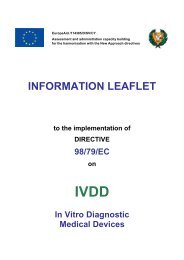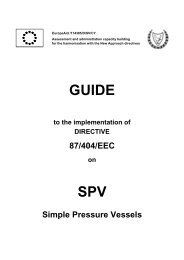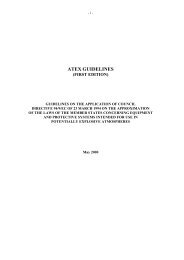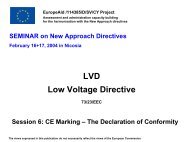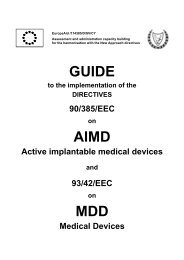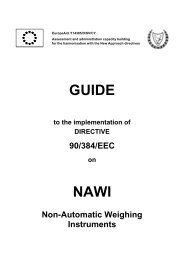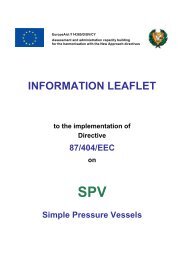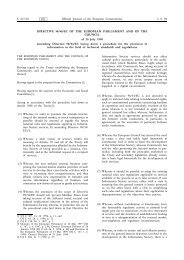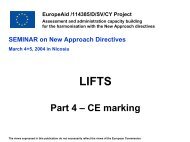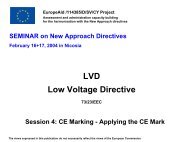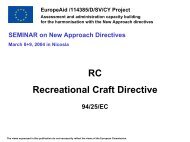Non-Automatic Weighing Instruments
Non-Automatic Weighing Instruments
Non-Automatic Weighing Instruments
Create successful ePaper yourself
Turn your PDF publications into a flip-book with our unique Google optimized e-Paper software.
EuropeAid /114385/D/SV/CY Project<br />
Assessment and administration capacity building<br />
for the harmonisation with the New Approach directives<br />
SEMINAR on New Approach Directives<br />
March 4+5, 2004 in Nicosia<br />
<strong>Non</strong>-<strong>Automatic</strong> <strong>Weighing</strong><br />
<strong>Instruments</strong><br />
90/384/EEC<br />
The views expressed in this publication do not necessarily reflect the views of the European Commission.
The Directive<br />
• Council Directive of 20 June 1990 on the<br />
harmonization of the laws of the Member<br />
States relating to non-automatic weighing<br />
instruments (90/384/EEC)<br />
• Published in the Official Journal of the<br />
European Communities L 189, 20.07.1990.<br />
• Amended by Council Directive 93/68/EEC of<br />
22 July 1993 (The CE marking Directive)<br />
February 2004 Practical Implementation of European New Approach Directives 2
Structure of the Seminar<br />
• Overview of the Directive<br />
• Essential requirements<br />
• Conformity Assessment Procedures<br />
• Harmonized Standard EN 45501<br />
• Interpretation by Notified Bodies: WELMEC<br />
Guidelines<br />
February 2004 Practical Implementation of European New Approach Directives 3
Overview of the Directive<br />
• The Directive is a New Approach Directive<br />
– Articles on<br />
• Scope<br />
• Free Movement, Market Surveillance<br />
• Conformity Assessment<br />
• Harmonized Standards<br />
• Notified Bodies<br />
• CE marking<br />
• Final provisions<br />
February 2004 Practical Implementation of European New Approach Directives 4
Overview of the Directive<br />
– Annexes:<br />
• I:<br />
• II:<br />
• III:<br />
• IV:<br />
• V:<br />
• VI:<br />
Essential requirements<br />
- EC type-examination (module B),<br />
- EC declaration of type conformity (module D),<br />
- EC verification (module F),<br />
- EC unit verification (module G)<br />
Design documentation<br />
Markings and inscriptions<br />
Minimum criteria for Notified Bodies<br />
CE conformity marking<br />
February 2004 Practical Implementation of European New Approach Directives 5
Scope<br />
• The applies to all non-automatic weighing<br />
instruments (nawi) (art. 1 (1))<br />
• Compliance with the essential requirements is<br />
only required for nawi used in specific<br />
applications (art. 3)<br />
• The Directive requires control of instruments in<br />
use (art. 13)<br />
February 2004 Practical Implementation of European New Approach Directives 6
Definition (art. 1(1))<br />
• A weighing instrument is a measuring<br />
instrument to determine the mass of a body by<br />
using the action of gravity on that body.<br />
• A weighing instrument is non-automatic when<br />
the intervention of an operator is required<br />
during weighing.<br />
February 2004 Practical Implementation of European New Approach Directives 7
Category of Use: Art. 1.2.a<br />
• <strong>Instruments</strong> used to determine mass for:<br />
– commercial transactions,<br />
– calculation of a toll, tariff, tax, bonus, penalty,<br />
remuneration, indemnity, or similar payment,<br />
– application of laws and regulations, expert opinions<br />
in court proceedings,<br />
– weighing patients in the medical practice,<br />
– medicin recipes in pharmacies and analysis in<br />
pharmaceutical laboratories<br />
February 2004 Practical Implementation of European New Approach Directives 8
Category of Use: Art. 1.2.b<br />
• <strong>Instruments</strong> used for other purposes than listed<br />
in art. 1.2.a.<br />
• These instruments<br />
– must not comply with the essential requirements;<br />
– must not bear the CE marking (under this<br />
Directive)<br />
February 2004 Practical Implementation of European New Approach Directives 9
• art. 4:<br />
Free Movement<br />
– member States shall not impede placing on the<br />
market (all nawi) or putting into service (nawi used<br />
for art. 1.2.a applications) of instruments that meet<br />
the requirements<br />
February 2004 Practical Implementation of European New Approach Directives 10
• Art. 2:<br />
Market Surveillance<br />
– Member States shall ensure that instruments are not<br />
placed on the market (all nawi) or put into service<br />
(nawi for art. 1.2.a applications) unless they meet<br />
the requirements<br />
February 2004 Practical Implementation of European New Approach Directives 11
• Art. 5:<br />
Presumption of Conformity<br />
– member States shall presume conformity with the<br />
essential requirements when instruments comply<br />
with relevant harmonized European standards<br />
– references of harmonized European standards are<br />
published in the Official Journal of the European<br />
Communities<br />
– references are also available on:<br />
www.newapproach.org<br />
February 2004 Practical Implementation of European New Approach Directives 12
• Art. 7:<br />
Safeguard Clause<br />
– Where a Member State considers that instruments<br />
with CE marking do not meet the requirements<br />
• when properly installed, and<br />
• used for their intended purpose<br />
it shall take all necessary steps to:<br />
• withdraw the instruments from the market, or<br />
• prohibit or restrict placing on the market or putting into<br />
service of such instruments<br />
February 2004 Practical Implementation of European New Approach Directives 13
• Art. 8:<br />
Conformity Assessment<br />
– EC type examination (annex II.1)<br />
followed by:<br />
• EC declaration of type conformity (annex II.2),<br />
or<br />
• EC verification (annex II.3),<br />
or:<br />
– EC unit verification (annex II.4)<br />
February 2004 Practical Implementation of European New Approach Directives 14
• Art. 9:<br />
– Member States:<br />
Notified Bodies<br />
• may designate bodies to do conformity assessment,<br />
• apply minimum criteria (annex V),<br />
• notify designated bodies to the European Commission,<br />
– The Commission:<br />
• allocates an identification number to the NoBo,<br />
• published the rferences of the NoBo on the Offical<br />
Journal of the EC<br />
February 2004 Practical Implementation of European New Approach Directives 15
CE marking, Inscriptions<br />
• Art 10 and annex IV and annex VI:<br />
– CE marking<br />
– Supplementary data: - NoBo number<br />
- “green M”<br />
– Inscriptions (annex IV.2)<br />
February 2004 Practical Implementation of European New Approach Directives 16
Control of <strong>Instruments</strong> in Use<br />
• Art. 13:<br />
– Member States shall ensure that instruments<br />
bearing the CE marking continue to conform to the<br />
requirements.<br />
February 2004 Practical Implementation of European New Approach Directives 17
• Annex I<br />
Essential requirements<br />
• Metrological requirements:<br />
– units of mass<br />
– accuracy classes<br />
– classification<br />
– accuracy<br />
– influence quantities and time<br />
February 2004 Practical Implementation of European New Approach Directives 18
• Annex I<br />
Essential requirements<br />
• Design and construction requirements:<br />
– General<br />
– Indication of weighing results<br />
– printing of weighing results<br />
– levelling<br />
– zeroing, tare and preset tare devices<br />
– instruments for direct sales to the public<br />
– price labelling instruments<br />
February 2004 Practical Implementation of European New Approach Directives 19
Conformity Assessment<br />
• EC type examination (annex II.1)<br />
• EC declaration of type conformity (annex II.2)<br />
• EC verfication (annex II.3)<br />
• EC unit verification (annex II.4)<br />
• Common provisions (annex II.5)<br />
February 2004 Practical Implementation of European New Approach Directives 20
• Annex II.1<br />
EC Type examination<br />
– Manufacturer or authorized representative:<br />
• prepares a “type”and design documentation<br />
• applies for approval<br />
– Notified Body:<br />
• examines design documentation (annex III),<br />
• performs tests (EN 45501, WELMEC Guides),<br />
• issues EC type-approval certificate,<br />
• validity of certificate: 10 years.<br />
February 2004 Practical Implementation of European New Approach Directives 21
• Art. 8.1.a:<br />
EC Type examination<br />
• EC type examination not required for<br />
instruments without:<br />
– electronic components, and<br />
– a spring to balance the load.<br />
February 2004 Practical Implementation of European New Approach Directives 22
EC Declaration of Type Conformity<br />
• Annex II.2<br />
– Manufacturer:<br />
• operates quality system for production<br />
• issues declaration of conformity<br />
• affixes the CE marking<br />
– Notified Body:<br />
• evaluates and approves quality system<br />
• performs EC surveillance (includes audits)<br />
February 2004 Practical Implementation of European New Approach Directives 23
• Annex II.3<br />
EC Verification<br />
– Manufacturer or authorized representative:<br />
• issues declaration of conformity<br />
• affixes the CE marking<br />
– Notified Body:<br />
• evaluates and tests each instrument<br />
• issues certificate of conformity<br />
February 2004 Practical Implementation of European New Approach Directives 24
• Annex II.4<br />
EC Unit Verification<br />
– Instrument designed for specific application<br />
– Manufacturer:<br />
• issues declaration of conformity<br />
• affixes the CE marking<br />
– Notified Body:<br />
• evaluates and tests the instrument,<br />
• issues certificate of conformity<br />
February 2004 Practical Implementation of European New Approach Directives 25
• Annex II.5<br />
Common Provisions<br />
– Verification may take place anywhere, unless<br />
transport to place of use requires dismantling, etc.<br />
likely to affect metrological performance,<br />
– If performance is sensitive to gravity, verification<br />
may take place in two stages<br />
February 2004 Practical Implementation of European New Approach Directives 26
Harmonized Standards<br />
• For the essential requirements:<br />
– EN 45501: Metrological aspects of non-automatic<br />
weighing instruments;<br />
• for the manufacturer’s quality system:<br />
– EN ISO 9001:2000;<br />
• for the notified bodies:<br />
– EN 45000-series<br />
February 2004 Practical Implementation of European New Approach Directives 27
EN 45501<br />
• EN 45501: Metrological aspects of nonautomatic<br />
weighing instruments<br />
• Part 1:<br />
– Terminology<br />
– Metrological and technical specifications<br />
– Test procedures<br />
• Part 2:<br />
– Pattern evaluation report format<br />
February 2004 Practical Implementation of European New Approach Directives 28
WELMEC<br />
• WELMEC = European Cooperation in Legal<br />
metrology,<br />
• Founded by 18 European national metrology<br />
services in 1990 (MoU) in anticipation of the<br />
NAWI-Directive,<br />
• Aim is to harmonise practices (tests,<br />
evaluations) in legal metrology between<br />
notified bodies,<br />
• www.welmec.org<br />
February 2004 Practical Implementation of European New Approach Directives 29
WELMEC<br />
• Issues guides, such as:<br />
– 1: An Introduction to WELMEC<br />
– 2: Directive 90/384/EEC: Common Application<br />
– 2.1: Guide for Testing Indicators<br />
– 2.2: Guide for Testing Point of Sale Devices<br />
– 2.3: Guide for Examining Software<br />
– 2.4: Guide for Load Cells<br />
– 2.5: Guide for Modular Approach and Testing of PCc and<br />
other Digital Peripheral Devices<br />
February 2004 Practical Implementation of European New Approach Directives 30



